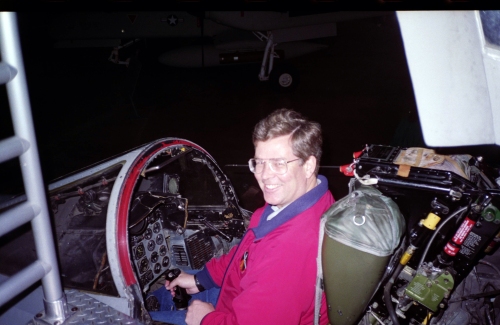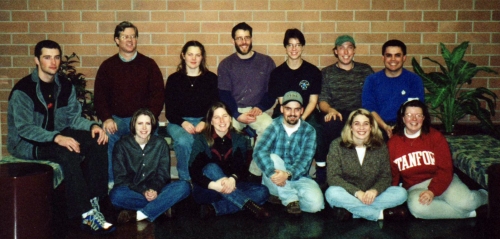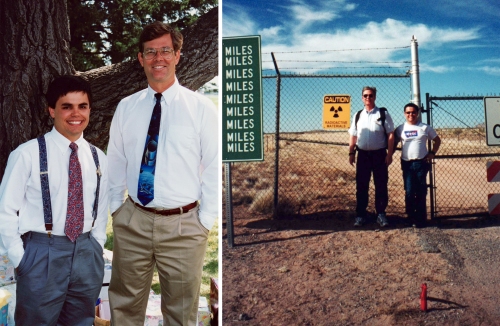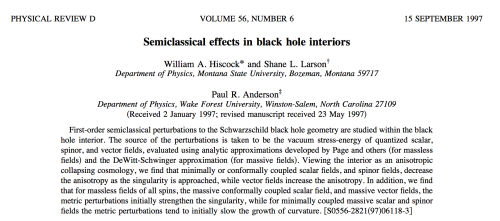by Shane L. Larson
I think the Universe is trying to tell me something. I was looking through one of my old papers, working on a new paper with a graduate student I know, and a random mouse-click in a PDF triggered the switch to my email. A new message window opened and addressed itself. I sat there for a moment, just staring. I hadn’t seen a window like this in almost four-and-a-half years. And just like that, I was crying. Again. In my office, by myself, but crying again. The email was to my graduate advisor, William (Bill) Hiscock, the man I called “Doc.” I don’t know why I called him Doc; it was a name only I used, but I used it until he passed away in April of 2009. I haven’t opened an email window like this since then.

Doc, on a trip he and I made to the Air Force Museum at Wright Patterson.
But there it was staring at me. I clicked open my contacts, and Doc’s address card is still there — his email address, his birthday, his home, mobile and office phone numbers, and in the notes field a simple notation: Died: 21 April 2009, Age 57. I don’t remember putting that in. I remember the phone call; my former postdoc mentor Ron Hellings called me that Tuesday morning. I was standing at my desk — I remember I was standing; isn’t that weird? — and Ron said “I want to tell you something, before you hear it second hand.” I cried then too; I don’t remember the rest of that day.
Since that day, I’ve shed a lot of tears, just about every time I think about Doc. I went home to Bozeman that May for a public memorial service, and spoke for all of us who had been his graduate students (my eulogy), and broke down. When I talk to student groups about my career, it is natural to talk about Doc and what he told me and what he taught me, and I break down every time. Ron and I were working one afternoon a couple of years ago and it happened again, and with a consoling hand on my shoulder Ron said, “For some people, you never quite get over losing them.”
Since Doc died, I’ve steadfastly avoided writing about him here; I’ve tried many times, and deleted it every time, stabbing at the delete key through tears. But it’s time to stop that. So much of what I am, of what I do, comes from his guidance. I need to write it down — to remind myself, to honor Doc, to remember.
Doc always talked about academic lineages as parents and children, and it is not an idea that is that far off the mark. He once had (and gave me a copy, which sadly I cannot find right now in the pile of papers that is my life) our academic family tree: Doc at the center, me and my graduate student cohorts at the bottom, and the vast tree of forebears that came before that all led to Doc. Sadly, I don’t know all the stories that led to Doc (I know a few), but I know some stories that led from Doc to me.

One of the early outreach teams for a program we first built with Doc, known today as SPOT (“Space Public Outreach Team”) and still going strong.
I was his graduate student from the time I entered graduate school in the fall of 1991 until I graduated in the spring of 1999. We continued to work together closely after I went on to my postdoctoral work, and ultimately to my permanent faculty position at Utah State University.
Doc was diligent in his duties as mentor to young scientists, particularly those of us desiring to enter a field as small and as competitive as gravity. Sometime during my first year, he sat me down and gave me the “Doom and Gloom” speech. It goes something like this: “There is maybe one faculty position in gravity in the country every year. You can’t expect to get a research job if you do this; you have to do it because you love it, and have plans for what to do when you graduate.” Like many students I am sure, I thought in my head “yeah, that won’t be me.” I’m sure Doc knew that, but he made sure he gave me the talking to; I give the same talk to each of my students.
Doc was a firm believer in the idea that a student had to sink or swim on their own, but he was always there nudging and pushing in the right directions to make sure we could make progress. Early on, he would give us projects to work on. Some of my earliest projects were in the area of “quantum field theory in curved spacetime.” It was always fun to call my folks and tell them that was what I was working on. 🙂 The idea is that traditionally, general relativity (gravity) as it is currently mathematically expressed, is not compatible with quantum mechanics (the fundamental, microscopic laws of Nature). We were working to better understand how quantum effects might change gravity. In order to do this we would (mathematically) throw quantum objects down a black hole and ask if the gravity of the black hole changed. It was fun and interesting, but it was purely mathematical, and a little bit esoteric.
Then, somewhere in the middle of my graduate career, I was at a national meeting with Doc. We were riding back from the meeting venue to the hotel one night on a charter bus. It was loud and raucous, filled with physicists arguing about research problems and telling jokes about fundamental constants and charged particles (that’s the kind of thing physicists do). I was sitting several rows back from Doc, and talking with Tim Olsen, who had been his first graduate student and was a professor at Salish-Kootenai College. Tim was asking what I was working on, and I remarked that it was cool stuff, but that I would really like to work on this new-fangled “gravitational wave” stuff I’d been reading about, because it seemed closer to astrophysics.
Now, I am quite sure Bill could not have heard this conversation over the laughing and physics jokes. But when we got off the bus and were walking into the hotel, he says to me, “So you want to work on gravitational waves?” He was always kind of omniscient that way. 🙂 He kept that in mind, and before too long my work, and ultimately my career, segued into gravitational wave astrophysics.
It wasn’t all seriousness and physics with Doc. One of best things about my graduate career was every day, he would walk into my office, and we’d go to lunch together. Every day. We’d walk over to the Strand Union Building on the MSU campus and have lunch. We’d talk about physics, politics at NASA, why Reed Richards was the best hero in comics, the history of space exploration, and cook up cool ideas together. Sometimes some of the other students would join us, but often it was just me and Doc.
We were at a Pacific Coast Gravity meeting one year, and Doc was sitting up far too late one night with his battalion of graduate students, regaling us with tales from his days as a student. He told us how to build match rockets, about pranks at Caltech, and had us all rolling on the floor with stories about rebuilding his carburetor. He once told me his plan to make a million dollars — selling bumper stickers that said, quite simply, “Stop the idiots.” He was a funny guy, Doc was.
I knew Doc for 18 years; I was his graduate student for less than half of those. All told, we published nine scientific papers together. I have notes scattered around for many more that we always wanted to get to, but never did. Somewhere along the way, I by-passed the Doom and Gloom model. I wrote papers, I got jobs, I got grants, I mentored students. I became a physicist. That was always the goal, right, Doc?
This past spring, I received my letter from Utah State University letting me know that I had been tenured and promoted to the rank of Associate Professor of Physics. While not the ultimate level of promotion for an academic scientist, the granting of tenure is one of the last major hurdles along the worldline of one’s career. At that moment, one leaves behind the “probationary period” when the world and the University is watching you closely to see if you can stand on your own two feet as a scientist. Now, on the far side of tenure they trust me to be a diligent and ethical scholar. All of Doc’s training, and patience, and prodding paid off. There are other challenges to come, both in science and career, but this is the mark that finally says “you made it.” So this year, I made it. But deep down I wish Doc was here to see it; I think we would have celebrated together.

(L) Doc and I at my wedding, two years after I started graduate school. (R) Doc and I at the Trinity Site, two years before I graduated with my PhD.
There are a thousand memories and stories I could tell, that I wish I could tell — I’m sure all of us who knew Bill wish the same wish. But I’d never be able to get it all out, and never be able to capture what I really want to capture; not really. But this little bit helps. In the end, I take great comfort in the fact that Doc and I both came from the same star stuff, and for a while, we were both engaged together in the game to understand that.
Death is inevitable, as important a part of the great design as birth, living, and evolving. Perishing is the last step in the great Cosmic design for all things — trees, rocks, planets, stars, and people. Eventually, I too will go back to the Cosmic cradle from whence we all came. Eventually. But for a few glorious years, I knew Doc, and we contemplated the Cosmos together.



Pingback: Memento Mori 2: From Pen, to Page, to Grave | Write Science